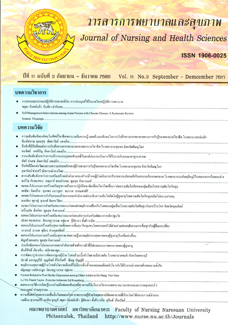Health Behavior of Patients after Receiving Coronary Stent and Stretch Support among Coronary Artery Disease without Recurrence of Stenosis
Main Article Content
Abstract
This qualitative research aimed to study health behavior among patients with coronary artery disease after receiving the coronary stent and stretch support but without a recurrence of stenosis. Twelve participants were in-depth interviewed from July to December, 2014. Non-participant observation was also applied to data collection. A content analysis, according to Morse and Field 1996, was applied to analyze the data. The finding showed the participants perceived the condition as having a chance of recurrence, happening suddenly, causing death, and returning to normalcy after being treated. Based on these perceptions, they stated three major categories of health routines. The first category was integrating medical treatment in daily living. The categories composed of four sub-categories including changing pattern of eating, taking medication as prescribed, following medical appointment, changing pattern of activities and managing emotional status doing distractions to community lifestyle and applying Buddhist concepts. The second category was learning and watching for abnormal signs. This category encompassed learning and watching for signs of stenosis and learning and watching for bleeding resulting from anticoaglulation drugs. The last category was receiving family support to benefit health behaviors.
Article Details
References
ไม่ติดต่อเรื้อรัง. สืบค้นเมื่อ 1 ธันวาคม 2558
จาก http://www.thaincd.com/informationstatistic/
non-communicable-disease-data.php.
กลุ่มงานข้อมูลสารสนเทศและการสื่อสารสำนักงาน
จังหวัดพิษณุโลก.(2556). บรรยายสรุปจังหวัด
พิษณุโลก. สืบค้นเมื่อ 10 เมษายน 2556
จาก www.phitsanulok.go.th/describe55/describe
55.doc .
ชณิตา ประดิษฐ์สถาพร, พิมพิ์สุภาว์ จันทนะโสตถิ์,
ขวัญใจ อำนาจสัตย์ซื่อ, และรัชนี สรรเสริญ. (2555).
สุขภาพจิตของผู้สูงอายุไทยตามแนววิถีพุทธ.
วารสารการพยาบาลสาธารณสุข, 26 (1), 69-79.
ณรงค์กร ชัยวงศ์. (2557). ปัจจัยที่มีอิทธิพลต่อ
พฤติกรรมการจัดการตนเองของผู้ป่วยโรค
กล้ามเนื้อหัวใจตายเฉียบพลัน. วิทยานิพนธ์
พย.ม., มหาวิทยาลัยบูรพา, ชลบุรี.
พระปลัดสมชาย ปโยโค. ( 2558). รูปแบบการดูแล
ผู้ป่วยโรคเรื้อรังเชิงพุทธบูรณาการ. วิทยานิพนธ์
พธ.ด. มหาวิทยาลัยมหาจุฬาลงกรณ์ราชวิทยาลัย,
กรุงเทพฯ.
พัชนีภรณ์ อึ้งรัตนชัย. (2550). ศึกษาผลลัพธ์ของการ
รักษาผู้ป่วยโรคกล้ามเนื้อหัวใจตายเฉียบพลัน
ที่ได้รับการขยายหลอดเลือดหัวใจชนิดปฐมภูมิ.
วิทยานิพนธ์ พย.ม. มหาวิทยาลัยมหิดล, กรุงเทพฯ.
ศิริพร จิรวัฒน์กุล. (2552). การวิจัยเชิงคุณภาพ
ด้านวิทยาศาสตร์สุขภาพ. กรุงเทพฯ : วิทยพัฒน์.
สมาคมแพทย์โรคหัวใจแห่งประเทศไทยในพระบรม
ราชูปถัมภ์. (2551). แนวปฏิบัติบริการสาธารณสุข
หัตถการรักษาโรคหลอดเลือดโคโรนารีย์
ผ่านสายสวน. สืบค้นเมื่อ 10 มิถุนายน 2556
จาก http://www.nhso.go.th/FrontEnd.
สุกัญญา แดงเรือง.(2550). ผลกระทบของการเจริญ
เติบโตของเมืองต่อวิถีชีวิตความเป็นอยู่ของ
ประชาชนในชุมชนนอกเขตเทศบาลนคร พิษณุโลก.
ปริญญา ศม., มหาวิทยาลัยเกษตรศาสตร์, กรุงเทพฯ.
สุจิตรา พิมพ์โพธิ์, ชนกพร จิตปัญญา และจรรยา
ฉิมหลวง. (2556). ความสัมพันธ์ระหว่างแบบ
แผนการดำเนินชีวิต การสนับสนุนทางสังคม
กลุ่มอาการกับภาวะซึมเศร้าของผู้ป่วยที่มี
ภาวะกล้ามเนื้อหัวใจตายเฉียบพลัน. วารสาร
มหาวิทยาลัยนราธิวาสราชนครินทร์, 5(1), 1-15.
อารีย์วรรณ์ อ่วมตานี. (2553). การวิจัยเชิงคุณภาพทางการ
พยาบาล.กรุงเทพฯ: จุฬาลงกรณ์มหาวิทยาลัย.
Dalby,M., Bouzamondo, A., & Lechat, P. (2003).
Transfer for Primary Angioplasty. Retrieved
May 5, 2013. From http://circ.ahajournals.org/
content/109/12/e175.full.
Smith, S.C., Feldman, T.E., Hirshfeld, J. W., Jacobs, A.
K., Kern, M. J., King, S. B., et al. (2005).
American heart association, ACC/AHA/ACAI 2005
guideline update for percutaneous coronary
intervention. American Heart Association, 67(1),
87-112.
World Health organization. (2015).Cardiovascular
diseases (CVDs). Retrieved April 1, 2015.
From http://www.who.int/mediacentre/
factsheets/fs317/en/.
Yan Fang wan, Xiao Lima, Chen Yuan, Ling Fei, Jing
Yang & Jun Zhang. (2015). Impact of daily
lifestyle on coronary heart disease. Retrieved
September 14, 2015, from http://eds.b. ebscohost.
com/eds/pdfviewer/pdfviewer?vid=35&
sid=c3a58355-b58a-45d7-9390-dafe99df0
cba%40sessionmgr114 &hid=114.


